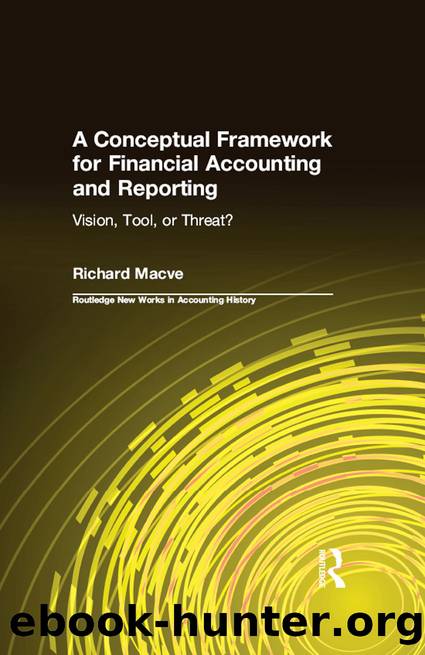A CONCEPTUAL FRAMEWORK FOR FINANCIAL ACCOUNTING AND REPORTING by RICHARD MACVE

Author:RICHARD MACVE
Language: eng
Format: epub
Publisher: Routledge
b)
the ability to obtain additional financing
c)
the amount of non-operating assets
d)
the ability to increase short-term funds flow by modifying operating and investing activities, including the ability to discontinue operations or sell operating assets (para.270).
A number of possibilities for giving information that would assist in assessing financial flexibility (and variations in it during the year) are suggested for comment, including information about borrowing facilities (and maximum and average borrowings outstanding during the year), credit ratings, and the separability and market values of assets; segregation of discretionary and non-discretionary expenses; and management comment and discussion of policy and plans.
Finally, some special matters relating to banks and insurance companies are considered.
REFERENCES—APPENDIX I
1. M. Moonitz, Obtaining Agreement on Standards in the Accounting Profession, op.cit.
2. See the reference to SEC requirements in FASB documents:
FAS33, ‘Financial Reporting and Changing Prices’, September, 1979.
Invitation to Comment on ‘Disclosures about Oil and Gas Producing Activities’, May 13, 1981.
Discussion Memorandum on ‘Reporting Funds Flows, Liquidity and Financial Flexibility’, December 15, 1980, chapter 10.
3. See for example A.J. Briloff, More Debits than Credits, New York: Harper & Row, 1976; The Truth about Corporate Accounting, New York: Harper & Row, 1980.
Download
This site does not store any files on its server. We only index and link to content provided by other sites. Please contact the content providers to delete copyright contents if any and email us, we'll remove relevant links or contents immediately.
Zero to IPO: Over $1 Trillion of Actionable Advice from the World's Most Successful Entrepreneurs by Frederic Kerrest(4078)
Machine Learning at Scale with H2O by Gregory Keys | David Whiting(3668)
Harry Potter and the Goblet Of Fire by J.K. Rowling(3620)
Never by Ken Follett(3550)
Ogilvy on Advertising by David Ogilvy(3356)
Shadow of Night by Deborah Harkness(3184)
The Man Who Died Twice by Richard Osman(2824)
Book of Life by Deborah Harkness(2727)
My Brilliant Friend by Elena Ferrante(2707)
How Proust Can Change Your Life by Alain De Botton(2621)
0041152001443424520 .pdf by Unknown(2613)
Will by Will Smith(2595)
The Tipping Point by Malcolm Gladwell(2566)
How to Pay Zero Taxes, 2018 by Jeff A. Schnepper(2508)
Purple Hibiscus by Chimamanda Ngozi Adichie(2505)
Hooked: A Dark, Contemporary Romance (Never After Series) by Emily McIntire(2428)
Rationality by Steven Pinker(2159)
Borders by unknow(2122)
Daughter of Smoke and Bone by Laini Taylor(2086)
